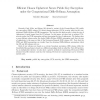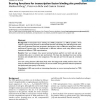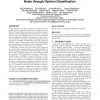120 search results - page 19 / 24 » How Much Can We Gain from Supervised Word Alignment |
WWW
2005
ACM
14 years 11 months ago
2005
ACM
In this paper we present the Infocious Web search engine [23]. Our goal in creating Infocious is to improve the way people find information on the Web by resolving ambiguities pre...
ASIACRYPT
2008
Springer
14 years 12 days ago
2008
Springer
Recently Cash, Kiltz, and Shoup [20] showed a variant of the Cramer-Shoup (CS) public key encryption (PKE) scheme [21] whose chosen-ciphertext (CCA) security relies on the computa...
BMCBI
2005
13 years 10 months ago
2005
Background: Transcription factor binding site (TFBS) prediction is a difficult problem, which requires a good scoring function to discriminate between real binding sites and backg...
AND
2010
13 years 7 months ago
2010
On the Internet, users often encounter noise in the form of spelling errors or unknown words, however, dishonest, unreliable, or biased information also acts as noise that makes i...
PAMI
2007
13 years 10 months ago
2007
—Fingerprint friction ridge details are generally described in a hierarchical order at three different levels, namely, Level 1 (pattern), Level 2 (minutia points), and Level 3 (p...



